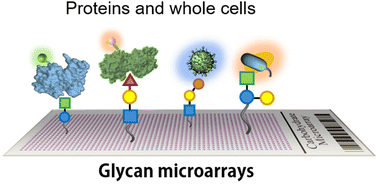Enzyme-Glycan Microarray Service
- Sample Types
- Storage and Transportation
- Enzyme Substrate Specificity Studies: Systematically identify an enzyme’s recognition patterns and catalytic preferences toward diverse glycan structures.
- Disease-Related Glycan Biomarker Discovery: Compare glycan processing differences between healthy and diseased samples to screen for potential diagnostic or prognostic biomarkers.
- Drug Target and Inhibitor Screening: Evaluate the inhibitory or activating effects of candidate molecules on target enzyme activity.
- Pathogen Recognition and Vaccine Development: Investigate how pathogens utilize glycan structures for infection and explore glycan-based immunization strategies.
- Fundamental Glycobiology Research: Map functional changes of enzymes under various physiological or environmental conditions to elucidate the systemic regulatory network of glycosylation.
Enzyme-Glycan Microarray Service immobilizes structurally defined and diverse glycans onto a solid support for parallel reactions with target enzymes, integrating fluorescence, chemiluminescence, or mass spectrometry detection to systematically characterize the binding patterns and catalytic properties between enzymes and various glycans. This service comprehensively maps enzyme substrate specificity and assesses changes in enzyme activity under varying conditions, providing high-quality data support for functional studies, drug screening, and biomarker discovery.
In glycobiology and glycomics research, glycosylation-related enzymes, such as glycosyltransferases and glycosidases, are key catalytic factors responsible for constructing, modifying, and degrading glycan structures. Their substrate specificity, reaction kinetics, and regulatory mechanisms directly influence glycan diversity and function. Glycans, as core modifications of macromolecules such as proteins and lipids, participate in diverse biological processes including cell signaling, immune responses, and pathogen recognition. Traditional enzyme activity assays face limitations in substrate diversity, detection throughput, and structural coverage, making it challenging to fully define the spectrum of enzyme-glycan interactions. The development of the Enzyme-Glycan Microarray enables high-throughput, parallelized analysis of multiple glycan substrates on a single platform, providing a systematic solution for basic research, disease mechanism studies, and glycoengineering applications.
MtoZ Biolabs offers Enzyme-Glycan Microarray Service to simultaneously evaluate the binding properties and catalytic activity of target enzymes against a wide range of structurally defined glycans on a single chip. By integrating multiple detection modalities, including fluorescence, chemiluminescence, and mass spectrometry, this service provides a comprehensive interaction profile between enzymes and glycans, delivering systematic and reproducible experimental data to support glycosylation mechanism research, functional validation, drug screening, and biomarker discovery.

Kim Y. et al. Chem Soc Rev. 2022.
Analysis Workflow
The main workflow of the Enzyme-Glycan Microarray Service is as follows:
1. Glycan Array Construction
Structurally confirmed glycans of various types are immobilized onto a solid substrate through covalent or non-covalent interactions to create a high-density array.
2. Sample Incubation
The target enzyme (or enzyme-containing sample) is incubated with the glycans on the array surface, allowing binding to substrates and catalysis to occur.
3. Signal Detection
Depending on the research objectives, binding or catalytic signals are detected using fluorescence labeling, enzymatic colorimetric assays, or mass spectrometry, ensuring both sensitivity and specificity.
4. Data Acquisition and Analysis
Signal intensity data are collected and processed using specialized software for background subtraction, normalization, and statistical analysis, generating enzyme–substrate binding heatmaps and kinetic curves.
Service Advantages
High-Throughput Detection: A single experiment can simultaneously assess the interactions between hundreds of glycans and multiple enzymes.
Low Sample Consumption: Suitable for studies involving rare samples or enzymes available only in small quantities.
High Sensitivity and Specificity: Accurately captures interaction signals of low abundance or weak affinity.
Comprehensive Data Analysis: Delivers substrate specificity profiles, kinetic parameters, and functional annotations to support both research and applied studies.
Customizable Service: Offers tailored glycan array design, optimized detection conditions, and integrated data analysis.
Sample Submission Suggestions
Acceptable samples include purified enzyme preparations, cell lysates, tissue extracts, or culture supernatants containing the target enzyme.
Samples should be stored at low temperatures (≤ -20°C) and shipped on dry ice, avoiding repeated freeze–thaw cycles.
It is recommended to consult with the MtoZ Biolabs technical team prior to sample submission to discuss experimental objectives and sample characteristics, and to obtain a detailed, tailored sample preparation and submission guide.
Applications
Example applications of Enzyme-Glycan Microarray Service:
Related Services
How to order?







